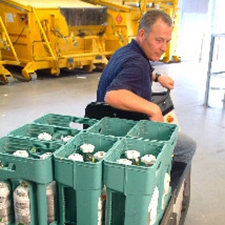Internal transport

Instructions for internal transport:
- Transport rules apply to the transport of hazardous substances and hazardous waste.
- Maintain the original shipping packaging as much as possible.
- The warning labels, both of the transport and the consumer packaging, must be clearly legible.
- Make sure that bottles, jars and barrels are clean on the outside.
- Never pick up a loose bottle by the cap. The cap can come loose, especially if it is not tightened properly. The bottom of the cap and the top of the neck of a bottle may be contaminated after use.
- Certainly for transporting multiple bottles, use a carrier, transport container or closed carrier.
- Avoid lifting too heavy. Use means of transport for the transport of loose packaging, bottles, barrels and jars.
- Prevent theft. Use a lockable cage on the transport cart.
- A transport barrow must be stable and have a closed loading surface with raised edges.
- Make sure that the packaging on the transport barrel cannot fall over.
- Place liquids and highly toxic substances in drip trays. The packaging must be tightly closed.
- In principle, do not transport hazardous substances with the pneumatic tube system. There is always a risk of leakage in the system in the event of breakage. For blood samples and cytostatics, use a leak-proof and transparent tube cartridge.
- Transport gas cylinders with suitable transport trolleys.
- Plan a transport route with hazardous (waste) substances, preferably not via busy corridors and elevators. In terms of transport times, always keep in mind the visiting hours.
- Never leave hazardous substances unattended.
- When unpacking packaged hazardous materials, pay attention to any breakage or leakage.
- Carefully unloads boxes of chemicals. Always keep it upright, especially if there are directional arrows (orientation arrows) on it. Do not let boxes land the floor to avoid breakage.

- Transport of carcinogens (such as cytostatics) in a closed transport package with inscription on the contents that protect against breakage and leakage.
- You may only transport cryogenic substances such as liquid nitrogen in a passenger lift under certain conditions. Transport the drum stably and do not transport more than 1 liter of liquid nitrogen in a lift in which people are also present. Transport a larger amount of nitrogen with two people: the first person operates the elevator from the outside with a key switch and the second person receives the elevator with the barrel of nitrogen on the designated floor. No persons may be present in the elevator. Read more about this in Working safely with cryogenic substances.
The environmental permit may include additional requirements for the safe transport of hazardous substances between and within the buildings of a umc.
